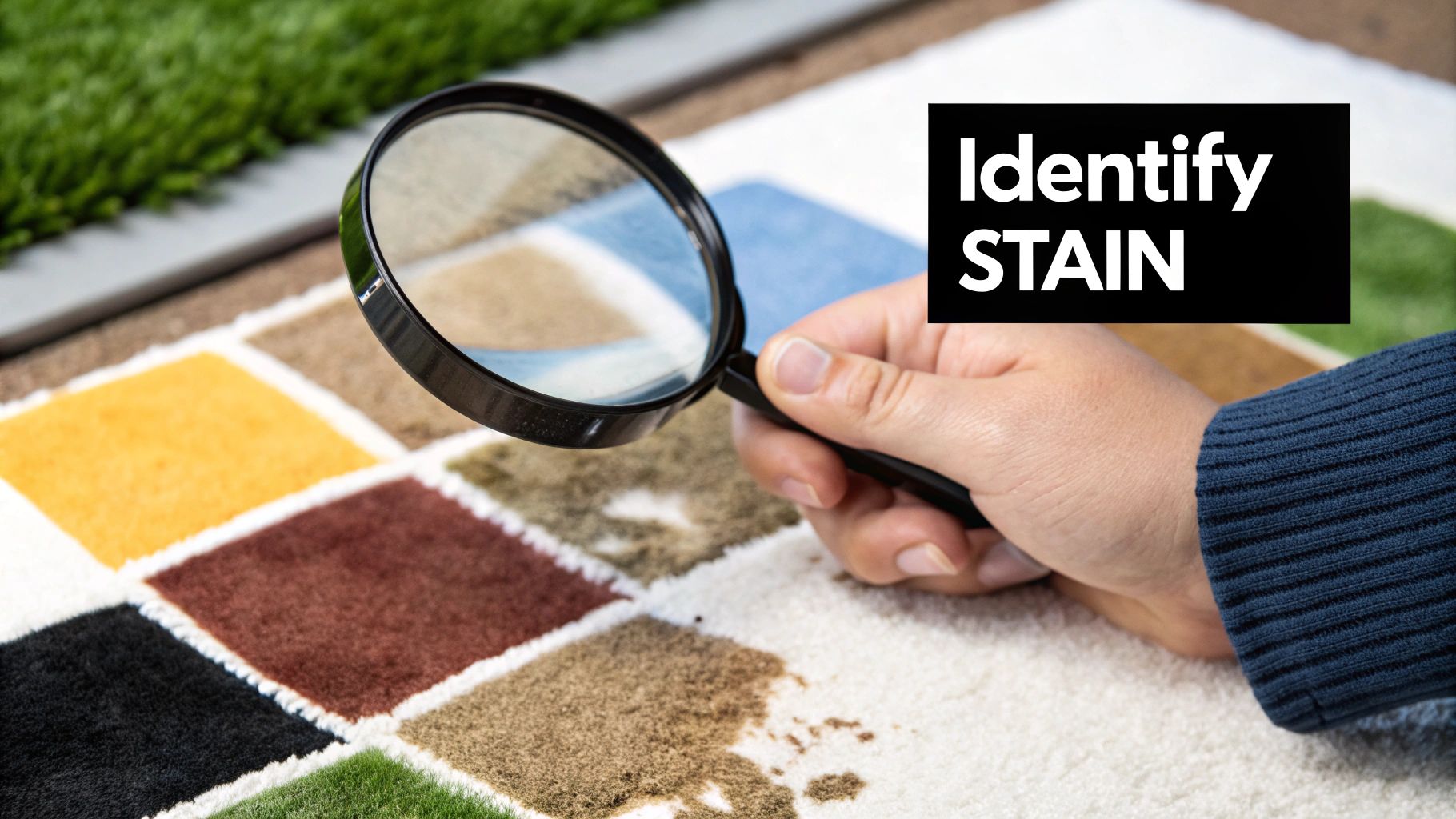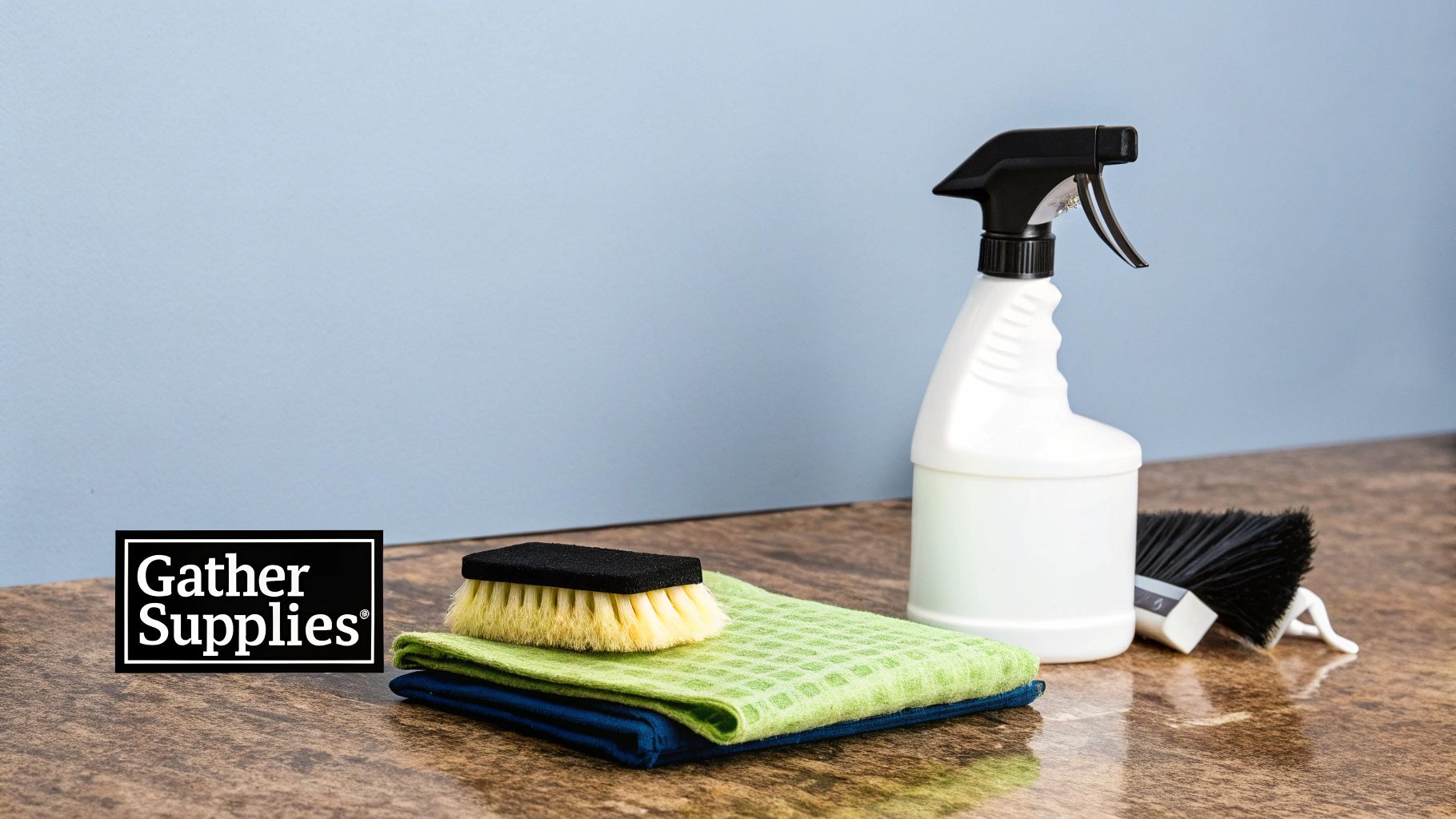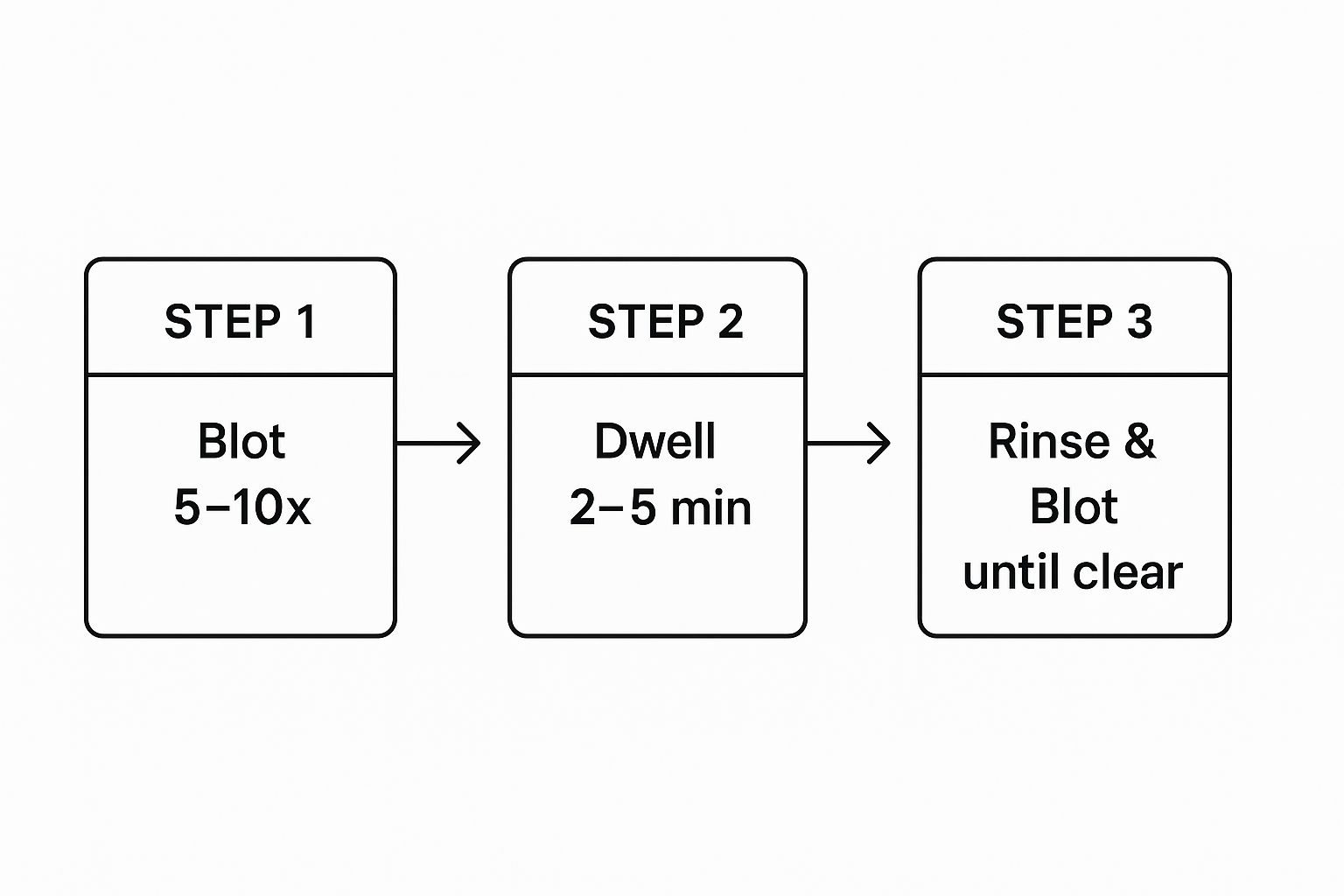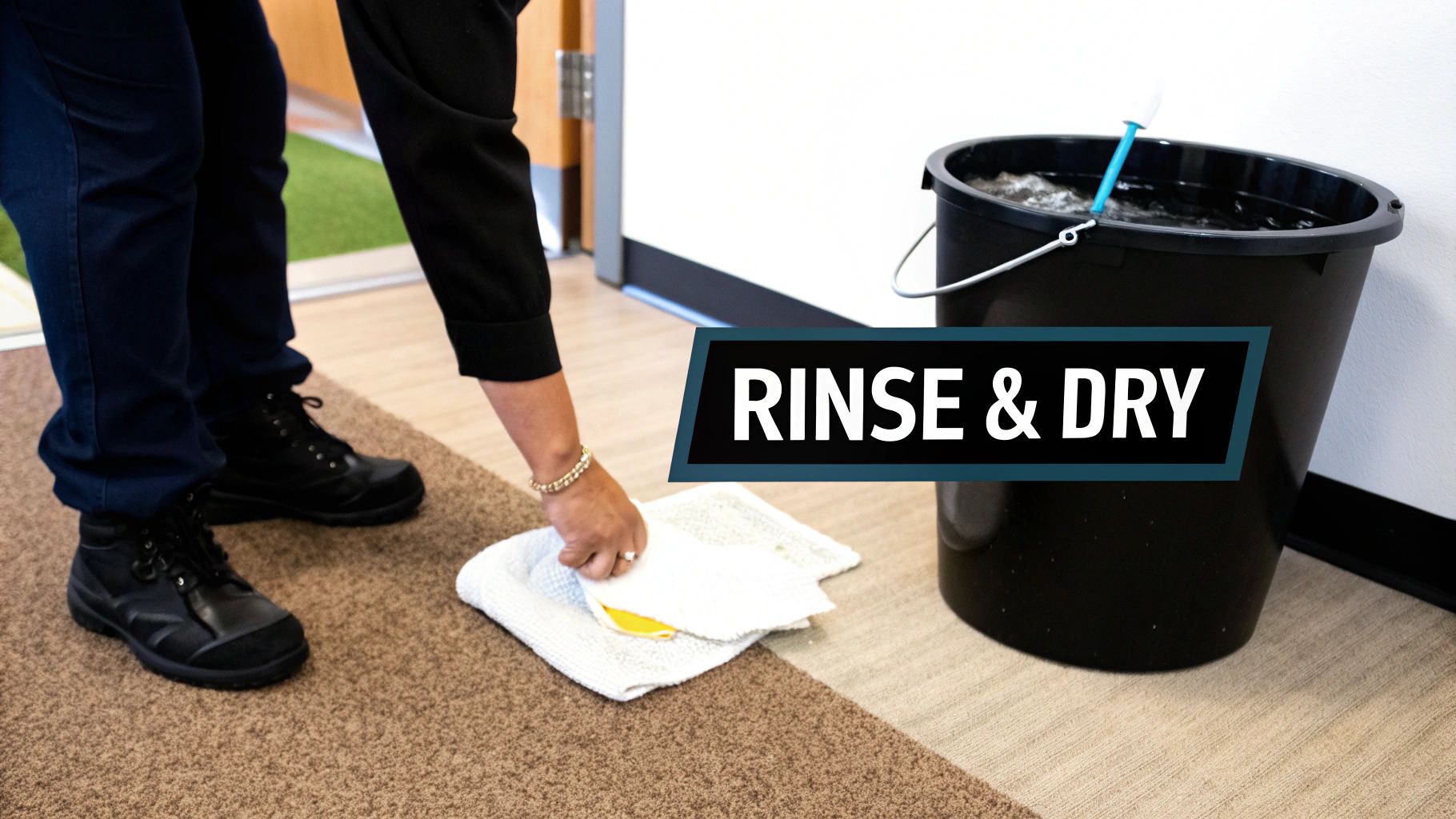When it comes to carpet stains, time is your enemy. The absolute best thing you can do is act fast. Grab a clean cloth and start blotting the spill immediately. Always work from the outside of the stain inward—this keeps it from spreading and becoming a bigger headache.
Whatever you do, don't scrub. Scrubbing just grinds the stain deeper into the carpet fibers and can permanently damage them. Believe me, your immediate response is the single most important factor in whether that stain comes out or not.
What to Do Immediately After a Spill

That moment of panic when a cup of coffee or glass of juice topples over is universal. Your first instinct might be to grab a brush and start scrubbing furiously, but please, resist that urge. Those first few minutes are all about damage control, and the right technique is everything. We're aiming for absorption, not aggressive cleaning.
The Right Way to Blot a Stain
Get a clean, white cloth (so no dye transfers to your carpet) or a thick stack of paper towels. Press it firmly down onto the spill. You're trying to soak up as much of the liquid as you possibly can.
Lift the cloth and you'll see the stain has transferred onto it. That's a good sign! Move to a fresh, clean section of the cloth and repeat the process. Keep blotting until your cloth is barely picking up any more moisture. This simple step removes the worst of the spill before it can set, making the actual cleaning part so much easier.
The golden rule of carpet care: Always blot, never rub. Rubbing frays the carpet fibers and pushes the stain deeper, making it almost impossible to remove later.
First Aid for Tough Spills
Dealing with something notorious like red wine or grape juice? You'll need to bring in some reinforcements. After you've blotted up as much as you can, grab some regular table salt from your kitchen.
Sprinkle the salt generously over the entire damp area. The salt crystals will work like tiny sponges, drawing the remaining moisture and pigment out of the carpet fibers as they dry. Just let it sit for a few hours (or even overnight) until it's completely dry, then vacuum it all up. This won't make the stain disappear completely, but it's a fantastic first-aid trick that buys you time and makes the final cleanup far more successful.
Your Carpet Stain Removal Toolkit

When a spill happens, panic sets in, and it's tempting to grab the first all-purpose cleaner you see. But hold on—that might actually set the stain and make things worse. The secret to success isn't speed alone; it's having the right tools ready to go.
Believe it or not, you don't need a cabinet full of expensive, specialized products. You can build an incredibly effective stain-fighting arsenal with a few simple things you probably already own. The most powerful solutions are often hiding in your pantry.
The DIY Cleaning Essentials
Think of these items as your first responders for spills. Whether it's muddy paw prints, a tragic coffee mishap, or a dropped slice of pizza, this core kit has you covered.
- White Vinegar: This mild acid is a miracle worker. It's fantastic for breaking down pet stains, coffee, and all sorts of other organic spots.
- Baking Soda: A true multi-tasker. It’s brilliant for absorbing wet spills, neutralizing nasty odors, and gently lifting the stain out of the carpet fibers.
- Dish Soap: Grab a clear, simple dish soap—the kind without any bleach or moisturizers. It’s an amazing degreaser for greasy or oily stains.
- Clean White Cloths: Always use white cloths or paper towels. Colored ones can bleed dye right into your carpet, creating a whole new problem.
Pro Tip: Keep these items together in a small caddy. When a spill happens, you can grab it and get to work in seconds instead of scrambling to find everything.
Want to round out your cleaning kit? For a more comprehensive checklist, check out our guide on the https://custom-maids.co/blogs/news/basic-cleaning-supplies-checklist you should always have.
It's no surprise that people are looking for better cleaning solutions. The global market for carpet cleaners was valued at a whopping USD 1.13 billion in 2023 and continues to grow. With this simple DIY toolkit, you get professional-grade results without spending a fortune.
Targeting Specific Stains with DIY Solutions
Not all stains are created equal. You wouldn't use the same approach for a greasy pizza smudge as you would for a knocked-over glass of red wine, right? Knowing what you're up against is half the battle, and it lets you pick the perfect homemade remedy to get the job done right.
The demand for effective, safe cleaning solutions has exploded. The global market for carpet cleaning products hit USD 1.81 billion in 2023, largely because people are actively looking for non-toxic options that work without filling their homes with harsh chemicals.
Defeating Common Household Stains
Let's get into the nitty-gritty of tackling some of the most common culprits you'll find on your carpet. Each one has a specific weakness, and you probably already have the tools to exploit it in your pantry.
- Coffee and Red Wine: These are tannin-based stains, and they hate acid. A simple mix of equal parts white vinegar and water is your go-to here. After you've blotted up as much as you can, give the spot a light spritz, wait a few minutes, and then blot again with a clean, dry cloth.
- Grease and Oil: Water and oil don't mix, so a different strategy is needed. Your first move should be to cover the stain with a generous amount of baking soda or cornstarch. Let it sit for at least 15-20 minutes to soak up the grease, then vacuum it all up. Follow up by dabbing the remaining mark with a drop of clear dish soap mixed in water.
- Pet Urine and Odors: When a pet has an accident, you're fighting both a stain and a lingering smell. That vinegar and water solution works wonders here too, as it helps neutralize the ammonia in the urine. For other tough biological messes, there's a specific process for https://custom-maids.co/blogs/news/how-to-remove-puke-from-carpet that can be a real lifesaver.
This visual guide walks you through the core process for hitting most fresh spills. It's all about blotting, applying your solution, letting it work its magic, and then rinsing.

As you can see, patience is a virtue. Giving your cleaning solution a few minutes to dwell and break down the stain is just as critical as that initial blotting.
Quick Guide to Homemade Stain Removers
To make things even easier, here’s a quick reference table I put together. It matches common stains with some of my favorite, easy-to-make DIY solutions.
| Stain Type | DIY Solution Recipe | Application Tip |
|---|---|---|
| Coffee, Tea, Wine | 1 part white vinegar, 1 part water | Spray lightly and let sit for 5-10 minutes before blotting. |
| Grease & Oil | Baking soda or cornstarch, then 1 tsp dish soap in 1 cup water | Absorb oil first with powder, then treat the residue. |
| Pet Urine | 1 part white vinegar, 3 parts water | Blot thoroughly; the vinegar neutralizes odor-causing ammonia. |
| Mud & Dirt | Let it dry completely, then a few drops of dish soap in warm water | Vacuum up all the dry debris first before tackling the stain. |
| Blood | Cold water with a small amount of clear dish soap | Always use cold water. Hot water will set the protein stain. |
This table should serve as a great starting point, but always remember to test any solution on a hidden area of your carpet first.
Handling Tricky and Unusual Stains
Every now and then, you'll run into something that seems like a real disaster—think a leaky pen or a drippy candle. Don't panic. These just require a more specialized technique.
For a water-based ink stain, a little rubbing alcohol on a clean cloth can lift it right out, but you absolutely have to test it on an inconspicuous spot first to ensure it doesn't damage your carpet's color. For more stubborn problems like wax, you can find detailed steps to get candle wax out of the carpet.
Key Takeaway: If you remember only one thing, make it this: match your solution to the stain type. An acidic cleaner like vinegar is perfect for organic stains, while a degreaser like dish soap is essential for oily ones.
When Your Cleaning Efforts Need a Boost

We've all been there. You've scrubbed and blotted with your trusted vinegar and baking soda mix, but that stubborn stain is laughing at you. Sometimes, especially with older stains that have really worked their way into the carpet fibers, a little elbow grease just isn't enough.
Knowing when to call it a day with your homemade solution is key. Pushing a DIY method too far can sometimes set the stain permanently or even damage the carpet itself. If you’ve given it a couple of honest tries and see zero progress, it's time to change your game plan.
That's your cue to look at commercial carpet cleaners. The cleaning aisle can be a bit much, I know. My advice? Zero in on a product designed for your specific problem, whether it's a pet accident, a greasy food spill, or that dreaded glass of red wine.
A Word of Caution: Before you go all-in with a new cleaner, always, always do a spot test. Find an inconspicuous spot—under the couch, in a closet—and apply a small amount. Let it dry completely. You need to be sure it won't bleach or damage your carpet before you put it front and center.
Bringing in the Heavy-Hitters
If a targeted spot cleaner still isn't cutting it, you might need to rent some serious hardware. I'm talking about carpet cleaning machines—the kind the pros use. These are a massive leap from just blotting with a cloth.
Deciding to go this route often comes down to understanding the difference between a quick tidy-up and a true deep clean. If you're curious about when a more intensive approach is needed for your whole home, take a look at our guide on deep cleaning vs regular cleaning.
When it comes to machines for tough stains, you generally have two options:
- Carpet Steam Cleaners: These use hot water vapor to sanitize and loosen surface-level grime. They’re fantastic for a general refresh but often lack the punch needed for deep-set stains.
- Carpet Extractors: These are the real workhorses. They spray a cleaning solution deep into the carpet pile and then use powerful suction to pull out all the dissolved dirt and moisture.
For serious stain removal, extractors are the industry standard. There's a reason the global market for these machines was valued at around USD 1.10 billion in 2024 and continues to expand. You can read more about the growth of the carpet cleaner market on imarcgroup.com. For those really tough, ground-in messes, renting an extractor is your most powerful move before you have to call in a professional service.
Of course, here is the rewritten section with a more natural, human-written feel.
Play the Long Game: Keeping Your Carpet Clean
Knowing how to zap a stain when it happens is a great skill to have, but let's be honest—the best stain is the one you never have to deal with in the first place. A little bit of prevention goes a long way and will save you a ton of future headaches and scrubbing.
Your vacuum is your absolute best friend here. Think of regular vacuuming as more than just a tidy-up; it's your frontline defense. All that dirt and grit that gets tracked in acts like sandpaper on your carpet fibers, slowly wearing them down. A worn-out carpet is a magnet for stains, making any future spill that much worse.
Building a Stain-Proof Fortress
A few simple house rules can make a massive difference in preventing messes before they even start. It's all about creating an environment where your carpet is protected.
- Go Shoeless: It might sound simple, but a strict no-shoes-in-the-house policy is a game-changer. You'd be shocked at the amount of grime, oil, and other stain-causing gunk that hitches a ride on the bottom of our shoes.
- Lean on Mats and Rugs: A good, sturdy doormat at every entrance is non-negotiable for trapping dirt at the door. For those areas that see a lot of foot traffic—think hallways and right in front of the sofa—an area rug can act as a sacrificial layer, protecting the carpet underneath from the daily grind.
The goal here isn't just about dodging stains; it's about making your carpet last longer. Consistent, simple maintenance is the secret to keeping your floors looking fresh for years.
If you really want to step up your game, grab a can of carpet protector spray after your next deep clean. These sprays create an invisible shield on the fibers. When a spill inevitably happens, the liquid will bead up on the surface, giving you those critical extra moments to grab a cloth and blot it up before it has a chance to set in.
Answering Your Toughest Carpet Stain Questions
Even when you know the basic cleaning steps, real-world stains can throw you a curveball. It’s one thing to read a guide, but another entirely to stare down a mystery spot that’s been there for who-knows-how-long. Let's dig into some of the most common questions that come up.
A big one I always hear is, "Will this cleaner bleach my carpet?" It’s a great question, especially if you have deep, vibrant colors. The most crucial habit you can ever develop is the spot test. Seriously. Never, ever skip this. Before a new cleaner touches the main part of your carpet, find a hidden spot—under a sofa, inside a closet—and test it there first.
Is It Ever Okay to Use Bleach on a Carpet?
My short answer? Almost never. Using standard chlorine bleach on most carpets, especially natural fibers like wool or silk, is a recipe for disaster. It won't just lift the stain; it'll strip the color right out, leaving a permanent white or yellowish splotch. It can even eat away at the fibers themselves.
The only time this isn't the case is with certain solution-dyed carpets, like some olefin or polypropylene types, which are specifically made to be bleach-safe. But unless you are 100% certain that's what you have, don't even think about it. There are so many safer options out there.
My personal rule is simple: if you're not a professional carpet cleaner, just don't do it. The risk of turning a temporary stain into a permanent bleach spot is way too high.
What’s the Deal with Old, Set-In Stains?
Tackling a stain that’s had weeks or months to set is a whole different ballgame. The molecules in the stain have had plenty of time to chemically bond with your carpet's fibers, making them incredibly stubborn. While acting fast is always ideal, an old stain isn't necessarily a lost cause.
You just need to adjust your strategy and have more patience. This isn't a one-and-done situation; you'll likely need to repeat your cleaning process a few times. One trick I’ve found that helps is to pre-soften the spot. Try laying a damp, warm towel over the stain for about 30 minutes before you start. This can help rehydrate and loosen the stain's grip, making your cleaning solution much more effective.
Feeling like you've met your match with a stain that just won't budge? Sometimes, the smartest move is to call in a professional. Custom Maids provides deep cleaning services that can handle the toughest spots, saving you the headache and restoring your carpet. Find out more about our cleaning packages.

